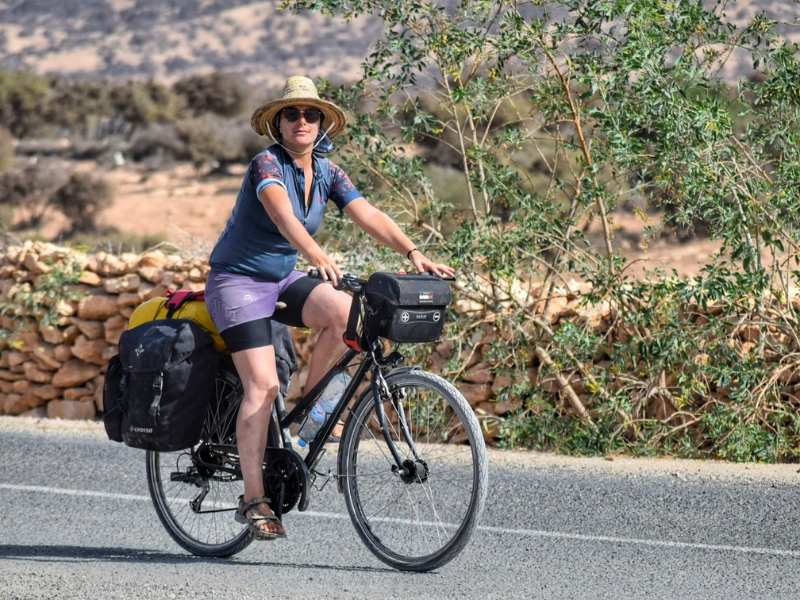Last Updated on 11 July 2024 by Cycloscope

One of the disadvantages of having a busy studying schedule is that you often need to sacrifice physical activities to meet the challenging deadlines of your assignments.
Nonetheless, physical activities like cycling are not only good for your body. Cycling can have a positive impact on academic performance in many ways.
By reducing stress and anxiety, improving memory and cognitive function, increasing blood flow, and providing a fun and social activity, cycling can help students perform better academically and achieve success in all areas of life.
How Cycling Can Improve Your Academic Performance

Reduces stress and anxiety
Stress and anxiety can be significant barriers to academic success, making it difficult to concentrate, remember information, and perform well on exams. Regular exercise, including cycling, can help reduce stress and anxiety, improving mental clarity, focus, and overall academic performance.
Improves memory and cognitive function
Exercise positively impacts memory and cognitive function by increasing blood flow and oxygen to the brain, which can help enhance learning and memory. A recent study found that cycling at moderate intensity for 30 minutes improved working memory and cognitive control in healthy young adults. By enhancing these cognitive abilities, cycling can help you to retain better and recall information, leading to improved academic performance.
Improves sleep quality and quantity
Cycling can improve overall physical fitness, leading to better sleep. Having a sound 8-hour sleep is the first step to better academic performance. It can be an excellent solution for those with trouble falling asleep or insomnia.
Positively impacts mood and mental health
As we thoroughly explained in our articles about the many benefits of Mountain Biking, cycling is a fun and social activity that can help improve mood and mental health, leading to better academic performance. Moreover, spending quality time together while cycling can become a regular activity for you and your friends. Cycling can help you socialize and meet new people as well. It is great to converse with someone with the same passion as you.
Improves key skills
You don’t have to be a pro in ultra-distance races to improve key skills through biking. Cycling enhances executive function, including planning, problem-solving, and decision-making skills. All of the listed skills are essential for academic success. When you are exercising, you allow your brain to rest. However, it does not mean you stop processing crucial questions in the background. For instance, if you can’t solve a math problem or can’t develop an exciting introduction to an essay, cycling is an excellent way of turning on your imagination.
Helps you relax
Students may have difficulties when it comes to getting some rest. It is not easy to switch off your brain when there are so many things you need to do. Cycling can be a great way to take a study break and get outside in nature. It can help to improve mental well-being and reduce stress. You can then get back to the unsolved problems of your academic routine.
What You Need to Know to Start Cycling

After reading these points, you might want to start cycling to see if it is as helpful as it seems. Starting cycling can be a fun and rewarding activity. It doesn’t require a lot of specialized equipment or training. With a little planning and preparation, anyone can start cycling and enjoy the benefits of this fun and healthy activity. Use these tips:
- Choose the right bike. The type of bike you choose will depend on the type of riding you plan to do. A hybrid bike or a road bike may be a good choice for commuting or leisure riding. Mountain bikes and gravel bikes are better suited for off-road riding. Consider your budget and your specific needs when choosing a bike. If you’re a plus-size have a look at our selection of bikes for big guys.
- Invest in a few essential accessories. A helmet is the most important accessory you’ll need. Other accessories include a lock, lights, and a pump to inflate your tires.
- Learn the rules of the road. Ensure you know the traffic laws and regulations for cyclists in your area. Even though you will not have to go through as many rules as in a driving school, you still need to learn the basics of traffic laws.
- Start slowly. If you’re new to cycling, start with shorter rides and gradually increase the distance and intensity. This approach will help you avoid injury and build endurance. Also, you will not find yourself demotivated because of being unable to meet the high expectations of your performance.
- Join a cycling club. Cycling clubs are great, that’s how MTB was born! Cycling with others can be a great way to stay motivated and improve your skills. Look for local cycling clubs or groups in your area, or start one with your friends.
- Do regular check-ups. Regular check-ups will help keep your bike in good condition. They will also reduce the risk of breakdowns or accidents. Learn how to perform basic maintenance tasks: cleaning your chain, checking your tire pressure, and tightening your brakes. You can find many tutorial videos online.
What Else You Should Know About Cycling
There are many more facts you can learn about cycling. For instance, it is a low-impact form of exercise. It is easy on the joints and is suitable for people of all fitness levels. This fact makes it an excellent choice for students with little exercise experience or those with preexisting joint pain or injuries. By making exercise accessible to more people, cycling can help to improve overall physical fitness and academic performance.
On top of that, cycling is one of the most efficient forms of transportation. It takes only about 35 calories to cycle a mile, making it more energy-efficient than walking, driving, or public transit. Think about it the next time you need to get from one place to another. Here are some more crucial points for your consideration. Following these guidelines allows you to enjoy cycling safely and get the most out of this fun and healthy activity.
- Always put safety first. Wearing a helmet, as well as following traffic laws when cycling, is essential. Remember that getting into an accident can be rather traumatic. It is an entirely different experience than getting into an accident when driving a car. There are no metal walls around you that can defend you from a shock wave. Therefore, be careful and try to avoid roads with heavy traffic.
- Stay hydrated. Drink water to stay hydrated and maintain high energy levels. Dehydration can cause muscle cramps, which can be painful and affect your ability to ride. Drinking water can help prevent these cramps and keep your muscles functioning properly. Also, dehydration can lead to dizziness and fainting. Consequently, it increases the risk of accidents and injuries. Staying hydrated helps you stay focused.
- Dress appropriately. Wear comfortable, breathable clothing that is appropriate for the weather conditions. Your body temperature can fluctuate when cycling, especially if you’re riding in changing weather conditions. Dress in layers so you can change your clothing when you get too hot or too cold. Consider wearing padded shorts and gloves to reduce discomfort and improve grip. It’s also important to be visible to drivers. Wear bright colors or reflective clothing to make yourself more visible, especially when riding at night or in low-light conditions.
- Plan your route. Before heading out, plan your route and familiarize yourself with the area. Planning your route can help you avoid busy or dangerous roads, reducing the risk of accidents and injuries. It can also help you find scenic routes to explore, enhancing your ride enjoyment. Finally, if you’re new to an area or unfamiliar with the roads, planning your route can help you navigate and avoid getting lost.
Did you know that there are more bicycles in the Netherlands than people? There are around 23 million bicycles in the country. Who knows, maybe cycling will become so popular among U.S. students that this number will no longer be a record. You know now about all the benefits and positive impacts of cycling. You also know what to do to start cycling without bringing any damage to your health. The only thing to do now is to give it a try.
If you don’t want to buy a bike just yet, ask a friend to borrow one. Remember that it might be challenging to learn how to cycle. Find a flat, open space with plenty of room to practice cycling. A park or empty parking lot can be a good option. It is okay to fall from a bike, get up, and try again. Of course, some people manage to learn how to cycle without falling. But it does not mean that they are better cyclists. Begin by sitting on the bike with your feet on the ground and your hands on the handlebars. Practice balancing by lifting your feet off the ground for a few seconds at a time. Just take as much time as you need and enjoy the process.


